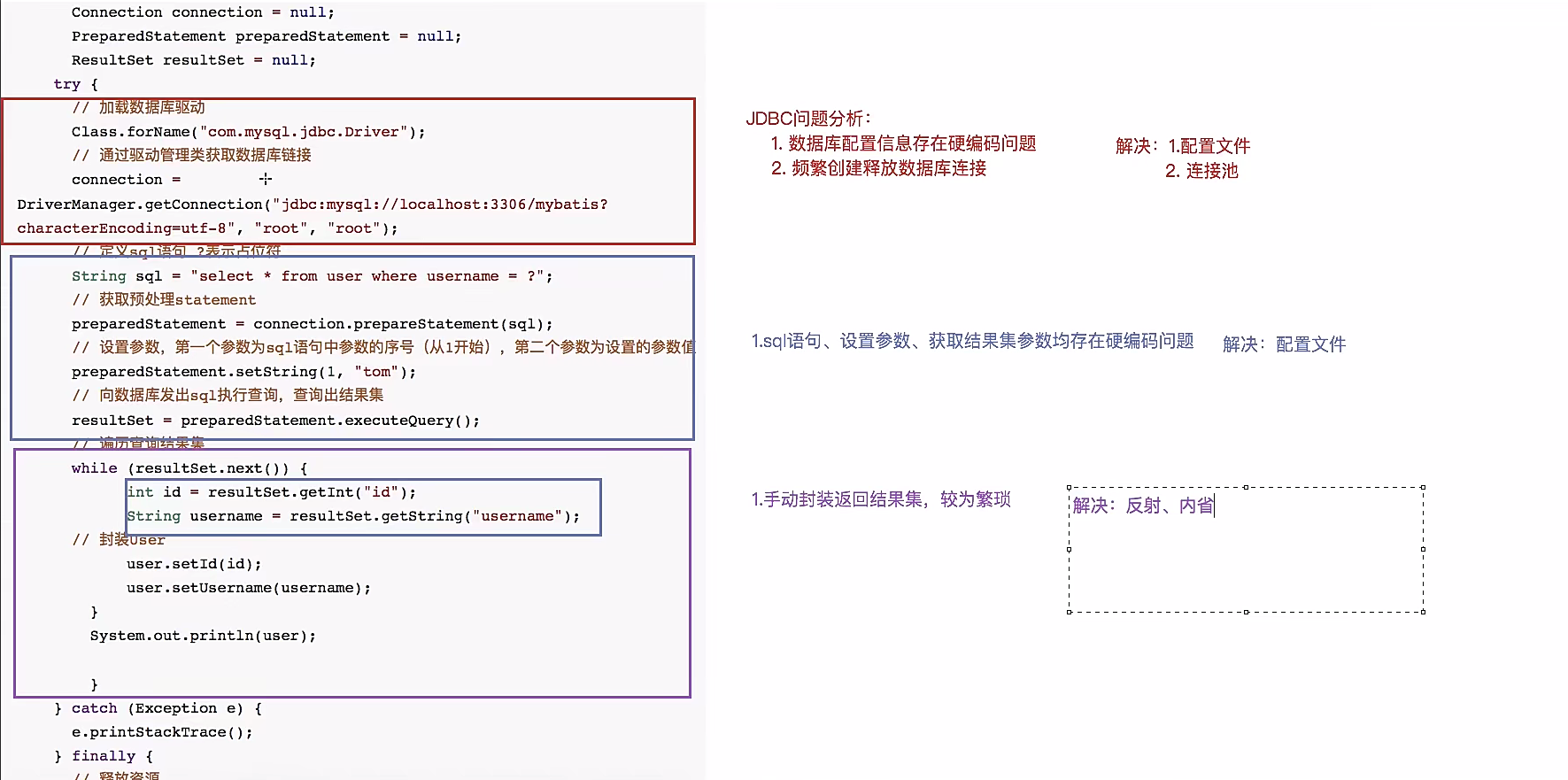自定义持久层框架
下图是JDBC引起的一系列问题以及解决办法:

自定义持久层框架设计思路:
使用端(项目):引入自定义持久层框架jar包。
提供两部分配置信息:1,数据库配置信息;2,sql配置信息--(sql语句、参数类型、返回值类型)
解决办法:使用配置文件来提供两部分配置信息:
<1>sqlMapConfig.xml:放数据库配置信息;在sqlMapConfig.xml中,其实也可以存放mapper.xml的全路径,方法getResourceAsSteam()可以一次性全部读取;
<2>mapper.xml:存放sql配置信息;自定义持久层框架本身(工程):本质上就是对JDBC代码进行了封装。
(1)加载配置文件,根据配置文件的路径,加载配置文件成字节输入流,存储在内存中;
创建Resource类
方法:getResourceAsSteam(String path)返回 InputSteam;(2)创建两个javaBean(容器对象):存放的就是对配置文件解析出来的内容,如下:
Configruation核心配置类:存放sqlMapConfig.xml解析出来的内容;
MappedStatement映射配置类:存放mapper.xml解析出来的内容;(3)解析配置文件,可以采用dom4j对配置文件进行解析;
创建类:SqlSessionFactoryBuilder,方法:build(InputSteam is)
<1>使用dom4j解析配置文件,将解析出来的内容封装到容器对象中;
<2>创建SqlSessionFactory对象;主要作用就是利用工厂模式生产sqlSession(会话对象)(4)基于开闭原则创建SqlSessionFactory接口及实现类DefaultSqlSessionFactory
<1>生产sqlSession【openSqlSession()】(5)创建SqlSession接口及实现类DefaultSession
定义对数据库的crud操作:selectList()selectOne()update()delete()(6)创建Exeutor接口及实现类SimpleExeutor实现类,执行的就是JDBC代码;
query(Configruation,MappedStatement,Object ... params);
创建两个maven工程IPersistence和IPersistence_test
--IPersistence_test引入IPersistence依赖--
<groupId>com.yun</groupId>
<artifactId>IPersistence_test</artifactId>
<version>1.0-SNAPSHOT</version>
<!--引入自定义持久层框架依赖-->
<dependencies>
<dependency>
<groupId>com.yun</groupId>
<artifactId>IPersistence</artifactId>
<version>1.0-SNAPSHOT</version>
</dependency>
</dependencies>
--IPersistence_test-->sqlMapConfig.xml--
<configuration>
<!--数据库配置信息-->
<dataSource>
<property name="driverClass" value="com.mysql.jdbc.Driver"></property>
<property name="jdbcUrl" value="jdbc:mysql://xxx.xxx.xx.xxx:xxxx/xxxx"></property>
<property name="username" value="xxxx"></property>
<property name="password" value="xxxx"></property>
</dataSource>
<!--存放mapper.xml的全路径-->
<mapper resource="userMapper.xml"></mapper>
</configuration>
--IPersistence_test-->userMapper.xml--
<mapper namespace="user">
<!--sql的唯一标识应该是由 namespace.id来组成(statementId)-->
<select id="selectList" resultType="com.yun.pojo.User">
select * from user
</select>
<!--利用反射获取到user对象的参数-->
<select id="selectOne" resultType="com.yun.pojo.User" paramterType="com.yum.pojo.User">
select * from user where id = #{id} and username = #{username}
</select>
</mapper>
--IPersistence--
@Data
public class MappedStatement {
//id
private Integer id;
//返回值类型
private String resultType;
//参数值类型
private String paramterType;
//sql语句
private String sql;
}
--IPersistence--
@Data
public class Configuration {
private DataSource dataSource;
/**
* k:statementId
* v:封装好的MappedStatement对象
*/
Map<String,MappedStatement> map = new HashMap<>();
}
按照设计思路编写代码
--解析配置文件返回流
public class Resources {
/**
* 根据配置文件的路径,将配置文件加载成字节输入流,存储在内存中
* @param path
* @return
*/
public static InputStream getResourcesAsSteam(String path){
InputStream resourceAsStream = Resources.class.getClassLoader().getResourceAsStream(path);
return resourceAsStream;
}
}
@Data
public class Configuration {
private DataSource dataSource;
/**
* k:statementId
* v:封装好的MappedStatement对象
*/
Map<String,MappedStatement> map = new HashMap<>();
}
@Data
public class MappedStatement {
//id
private String id;
//返回值类型
private String resultType;
//参数值类型
private String paramterType;
//sql语句
private String sql;
}
--将解析的流封装到SqlSessionFactoryBuilder中
public class SqlSessionFactoryBuilder {
public SqlSessionFactory build(InputStream is) throws Exception {
//1,使用dom4j解析配置文件,将解析出来的内容封装到Configuration中
XmlConfigBuilder xmlConfigBuilder = new XmlConfigBuilder();
Configuration configuration = xmlConfigBuilder.parseConfig(is);
//2,创建sqlSessionFactory对象,工厂类:生产sqlSession绘画对象
DefaultSqlSessionFactory defaultSqlSessionFactory = new DefaultSqlSessionFactory(configuration);
return defaultSqlSessionFactory;
}
}
--将sqlMapConfig.xml和userMapper.xml流放入configuration中
public class XmlConfigBuilder {
private Configuration configuration;
public XmlConfigBuilder() {
this.configuration = new Configuration();
}
/**
* 该方法就是使用dom4j将配置文件解析,封装Configuration
* @param is
* @return
*/
public Configuration parseConfig(InputStream is) throws Exception {
Document document = new SAXReader().read(is);
//获取Configuration根对象<Configuration>
Element rootElement = document.getRootElement();
//获取sqlMapConfig.xml里面的配置信息并且遍历
List<Element> list = rootElement.selectNodes("//property");
Properties properties = new Properties();
for (Element element : list) {
String name = element.attributeValue("name");
String value = element.attributeValue("value");
properties.setProperty(name,value);
}
//创建 c3p0 连接池
ComboPooledDataSource comboPooledDataSource = new ComboPooledDataSource();
comboPooledDataSource.setDriverClass(properties.getProperty("driverClass"));
comboPooledDataSource.setJdbcUrl(properties.getProperty("jdbcUrl"));
comboPooledDataSource.setUser(properties.getProperty("username"));
comboPooledDataSource.setUser(properties.getProperty("password"));
configuration.setDataSource(comboPooledDataSource);
//mapper.xml解析 步骤:拿到路径-->加载成字节输入流-->dom4j进行解析
List<Element> mapperList = rootElement.selectNodes("//mapper");
for (Element element : mapperList) {
String mapperPath = element.attributeValue("resource");
InputStream resourcesAsSteam = Resources.getResourcesAsSteam(mapperPath);
XmlMApperBuilder xmlMApperBuilder = new XmlMApperBuilder(configuration);
xmlMApperBuilder.prase(resourcesAsSteam);
}
return configuration;
}
}
public class XmlMApperBuilder {
private Configuration configuration;
public XmlMApperBuilder(Configuration configuration) {
this.configuration = configuration;
}
public void prase(InputStream is) throws Exception {
Document document = new SAXReader().read(is);
Element rootElement = document.getRootElement();
String namespace = rootElement.attributeValue("namespace");
List<Element> list = rootElement.selectNodes("//select");
for (Element element : list) {
String id = element.attributeValue("id");
String resultType = element.attributeValue("resultType");
String paramterType = element.attributeValue("paramterType");
String sqlText = element.getTextTrim();
MappedStatement mappedStatement = new MappedStatement();
mappedStatement.setId(id);
mappedStatement.setResultType(resultType);
mappedStatement.setParamterType(paramterType);
mappedStatement.setSql(sqlText);
//key值是由 namespace.id来组成
String key = namespace +"."+id;
configuration.getMap().put(key,mappedStatement);
}
}
}
--利用工厂模式生产sqlSession
public class DefaultSqlSessionFactory implements SqlSessionFactory{
private Configuration configuration;
public DefaultSqlSessionFactory(Configuration configuration) {
this.configuration = configuration;
}
@Override
public SqlSession openSession() {
return new DefaultSqlSession(configuration);
}
}
@AllArgsConstructor
public class DefaultSqlSession implements SqlSession {
private Configuration configuration;
@Override
public <E> List<E> selectList(String statementId, Object... params) throws Exception {
//将要去完成对 SimpleExecutor 里的query方法的调用
SimpleExecutor simpleExecutor = new SimpleExecutor();
MappedStatement mappedStatement = configuration.getMap().get(statementId);
List<Object> list = simpleExecutor.query(configuration, mappedStatement, params);
return (List<E>) list;
}
@Override
public <T> T selectOne(String statementId, Object... params) throws Exception {
List<Object> objects = selectList(statementId, params);
if (objects.size() == 1) {
return (T) objects.get(0);
} else {
throw new RuntimeException("查询结果为空或者返回结果过多");
}
}
}
--注册驱动,查询数据信息 并且封装返回
public class SimpleExecutor implements Executor {
@Override //user
public <E> List<E> query(Configuration configuration, MappedStatement mappedStatement, Object... params) throws Exception{
//1,注册驱动,获取连接
Connection connection = configuration.getDataSource().getConnection();
//2,获取sql select * from user where id = #{id} and username = #{username}
//转换sql select * from user where id = ? and username = ?,转换过程中,还需要对#{}里面的值进行存储解析
String sql = mappedStatement.getSql();
BoundSql boundSql = getBoundSql(sql);
//3,获取预处理对象
PreparedStatement preparedStatement = connection.prepareStatement(boundSql.getSqlText());
//4,设置参数
//获取到参数的全路径
String paramterType = mappedStatement.getParamterType();
Class<?> paramterTypeClass = getClassType(paramterType);
List<ParameterMapping> parameterMappingList = boundSql.getParameterMappingList();
for (int i = 0; i < parameterMappingList.size(); i++) {
ParameterMapping parameterMapping = parameterMappingList.get(i);
String content = parameterMapping.getContent();
//反射根据content获取到实体对象中的属性值,再根据属性值获取到当前传过来的参数对象
Field declaredField = paramterTypeClass.getDeclaredField(content);
//暴力访问
declaredField.setAccessible(true);
Object o = declaredField.get(params[0]);
preparedStatement.setObject(i+1,o);
}
//5,执行sql
ResultSet resultSet = preparedStatement.executeQuery();
//获取实体对象
String resultType = mappedStatement.getResultType();
Class<?> resultTypeClass = getClassType(resultType);
//获取实体对象的具体实现
Object instance = resultTypeClass.newInstance();
List<Object> objects = new ArrayList<>();
//6,封装返回结果集
while (resultSet.next()) {
//1,取出元数据
ResultSetMetaData metaData = resultSet.getMetaData();
for (int i = 1; i <= metaData.getColumnCount(); i++) {
//获取字段名
String columnName = metaData.getColumnName(i);
//获取字段值
Object value = resultSet.getObject(columnName);
//使用反射或者内省根据数据库表和实体的对应关系,完成封装
PropertyDescriptor propertyDescriptor = new PropertyDescriptor(columnName, resultTypeClass);
Method writeMethod = propertyDescriptor.getWriteMethod();
writeMethod.invoke(instance,value);
}
objects.add(instance);
}
return (List<E>) objects;
}
/**
* 反射获取实体
* @param paramterType
* @return
* @throws Exception
*/
private Class<?> getClassType(String paramterType) throws Exception {
if (StringUtils.isNullOrEmpty(paramterType)) {
Class<?> aClass = Class.forName(paramterType);
return aClass;
}
return null;
}
/**
* 完成对#{}的解析工作:1,将#{}使用?进行代替;2,解析出#{}里面的值进行存储
* @param sql
* @return
*/
private BoundSql getBoundSql(String sql) {
//标记处理类:配置标记解析器来完成对占位符的解析处理工作
ParameterMappingTokenHandler tokenHandler = new ParameterMappingTokenHandler();
//标记解析器,对占位符的转换
GenericTokenParser tokenParser = new GenericTokenParser("#{", "}", tokenHandler);
//解析出来的sql
String parseSql = tokenParser.parse(sql);
//#{}里面的解析出来的参数名称
List<ParameterMapping> parameterMappings = tokenHandler.getParameterMappings();
BoundSql boundSql = new BoundSql(parseSql,parameterMappings);
return boundSql;
}
}
开始测试
public class IPersistenceTest {
@Test
public void test() throws Exception {
//获取配置文件流
InputStream resourcesAsSteam = Resources.getResourcesAsSteam("sqlMapConfig.xml");
SqlSessionFactory sqlSessionFactory = new SqlSessionFactoryBuilder().build(resourcesAsSteam);
SqlSession sqlSession = sqlSessionFactory.openSession();
//调用
User user = new User();
user.setId(1);
user.setUsername("张三");
User user2 = sqlSession.selectOne("user.selectOne", user);
System.out.println(user2);
}
}
结果:

种桃道士归何处,前度刘郎今又来。





【推荐】国内首个AI IDE,深度理解中文开发场景,立即下载体验Trae
【推荐】编程新体验,更懂你的AI,立即体验豆包MarsCode编程助手
【推荐】抖音旗下AI助手豆包,你的智能百科全书,全免费不限次数
【推荐】轻量又高性能的 SSH 工具 IShell:AI 加持,快人一步
· TypeScript + Deepseek 打造卜卦网站:技术与玄学的结合
· Manus的开源复刻OpenManus初探
· AI 智能体引爆开源社区「GitHub 热点速览」
· 三行代码完成国际化适配,妙~啊~
· .NET Core 中如何实现缓存的预热?